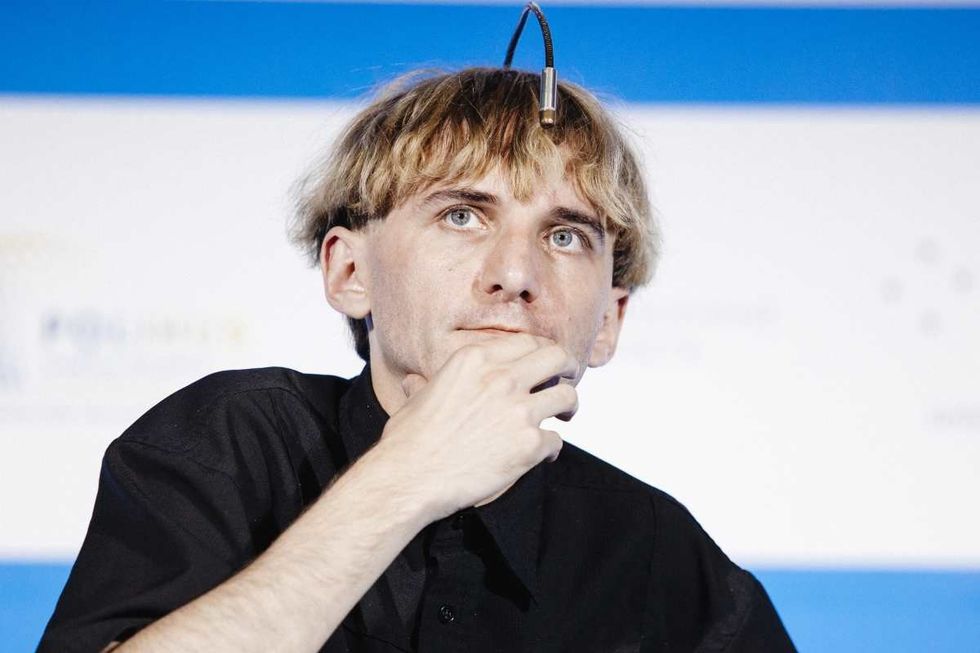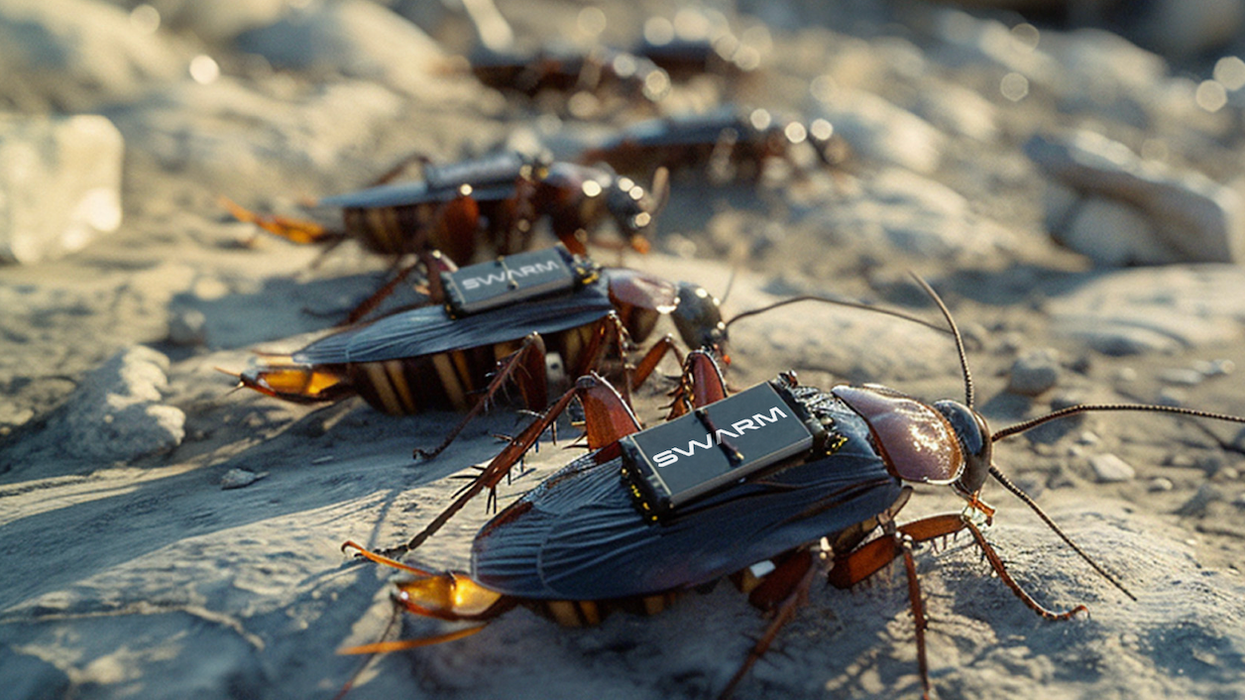Until nearly two decades ago, Neil Harbisson saw the world in black, white, and gray due to achromatopsia. But everything changed when he got an electronic eye, or “eyeborg,” implanted in his skull. Now, he can perceive colors—not by seeing them, but by hearing them. Recognized by Guinness World Records as the first official “cyborg artist,” Harbisson demonstrates the transformative power of technology.

A “cyborg” is a being enhanced by computer implants or mechanical body parts. Spain-based Harbisson became a cyborg to overcome his color blindness. For the past few years, he has been able to “hear” visible and invisible wavelengths of light. An antenna-like sensor implanted in his head translates different wavelengths into vibrations, which he perceives as sound.
“At first I had to memorize the color notes, but then it became a perception and perception became a feeling, and then like everyone else, I started having my favorite colors, and I started to dream in colors,” Harbisson spoke in his 2012 TED Talk, standing on the stage dressed in a cobalt blue shirt, pink coat, and yellow trousers. “Today I am dressed in C-major,” he quipped, “It's quite a happy chord!”
Harbisson’s life is unimaginable for those who live their lives with normal senses. Unlike most people, the cyborg listens to paintings and eats songs. He hears people’s faces and draws portraits of people with sound. However, his mysterious experience is not something supernatural, rather it stems from a futuristic technology that helped him become a cyborg.
Harbisson has a device implanted in his skull, which is essentially a camera that captures colors and translates them into sound frequencies via bone conduction. In his unique world, every color has a corresponding musical note: Red is F, orange is F sharp, G is yellow, C is blue, A is green, and B-minor is a mix of turquoise, purple, and orange. He listens to Warhols and Pantones, paints with sounds, and writes music based on what he sees.
He was born in Northern Ireland completely color-blind, with achromatopsia, a rare condition that limited him so he could see only in greyscale. Later in childhood, he moved to Barcelona and grew up obsessed with color and things he couldn't sense. So, he designed this device with an antenna to overcome his limitations. It was in 2003 when he collaborated with Adam Montandon, Associate Professor of Innovation at Denmark's Erhvervsakademiet Lillebælt Institute. Together, they created a revolutionary device called the 'eyeborg.'

Fixed on the wearer's head, the eyeborg converts light waves (colors) into sound waves. Through this, Harbisson can hear colors. In 2004, he got his skull bone drilled and this device fitted inside. As the bone gradually grew, it covered the device and the attached chip. “My mother was very scared, and she didn’t like it,” Harbisson recalled, per Guinness World Records. But once he got it done, his entire life changed and his perception shifted. While humans normally hear using “air conduction” with sound waves passing through the outer and middle ears and causing the inner eardrum to vibrate, Harbisson hears through “bone conduction.” The vibrations from his skull are transmitted to his inner ear.
The device in his skull also has Wi-Fi and Bluetooth, allowing him to receive images, videos, music, or phone calls directly into his head. Additionally, he can sense ultra-high and low frequencies, such as UV and infrared light, through his electronic eye.

The eyeborg, however, cannot be switched off, which means he constantly receives audible vibrations in his head. “It’s just like smell; we are always smelling, we are always hearing, we are always tasting, so I am always sensing color as well,” he explained, adding that the only way to stop it is to cover the sensor. Flowers are sometimes too noisy, he said.
Despite donning this unconventional device on his head, he is absolutely comfortable with himself and doesn’t feel disrupted in any way, “There is no difference between the software and my brain, or my antenna and any other body part. Being united to cybernetics makes me feel that I am technology,” he said while speaking to National Geographic.

As the world’s first cyborg, Harbisson co-founded the Cyborg Foundation in 2010, which he described as “a platform to help people become cyborgs.” “We put people in contact so that they can start teams to create new organs, and we also defend cyborgs as a cultural group,” he said. As much as he considers himself a trans-human, he thinks that everyone has the liberty to design their life in their own way.
When asked how his personal experience has changed after getting this device stitched into his brain, he said, “My understanding of the world has become more profound. The more you extend your senses, the more that you realize exists. If you’re in the same house for years, there’s a repetition of what you perceive there. If you add a new sense, though, the house becomes new again.” Harbisson added that with this groundbreaking device, he can connect with nature more deeply.

He further said that technological augmentation is a natural, and maybe even necessary, strategy for humans to adapt to an uncertain future. He also believes that this kind of technology has a promising future, “Imagine something like an earring that could give you 360 degrees of perception of your surroundings, and maybe it could buzz to tell you someone’s behind you. It’s strange to me that simple things like this aren’t happening.” In addition to his multiple projects, Harbisson also collaborated with Vodafone to create software that would capture Barcelona's Palau de la Musica’s vibrant blues, greens, and oranges, per Wired.





















 A road near equatorial Atlantic OceanCanva
A road near equatorial Atlantic OceanCanva Waves crash against rocksCanva
Waves crash against rocksCanva
 Older woman drinking coffee and looking out the window.Photo credit:
Older woman drinking coffee and looking out the window.Photo credit:  An older woman meditates in a park.Photo credit:
An older woman meditates in a park.Photo credit:  Father and Daughter pose for a family picture.Photo credit:
Father and Daughter pose for a family picture.Photo credit:  Woman receives a vaccine shot.Photo credit:
Woman receives a vaccine shot.Photo credit: 
 Image artifacts (diffraction spikes and vertical streaks) appearing in a CCD image of a major solar flare due to the excess incident radiation
Image artifacts (diffraction spikes and vertical streaks) appearing in a CCD image of a major solar flare due to the excess incident radiation
 Brady Feigl in February 2019.
Brady Feigl in February 2019.
 Yonaguni Monument, as seen from the south of the formation.
Yonaguni Monument, as seen from the south of the formation.